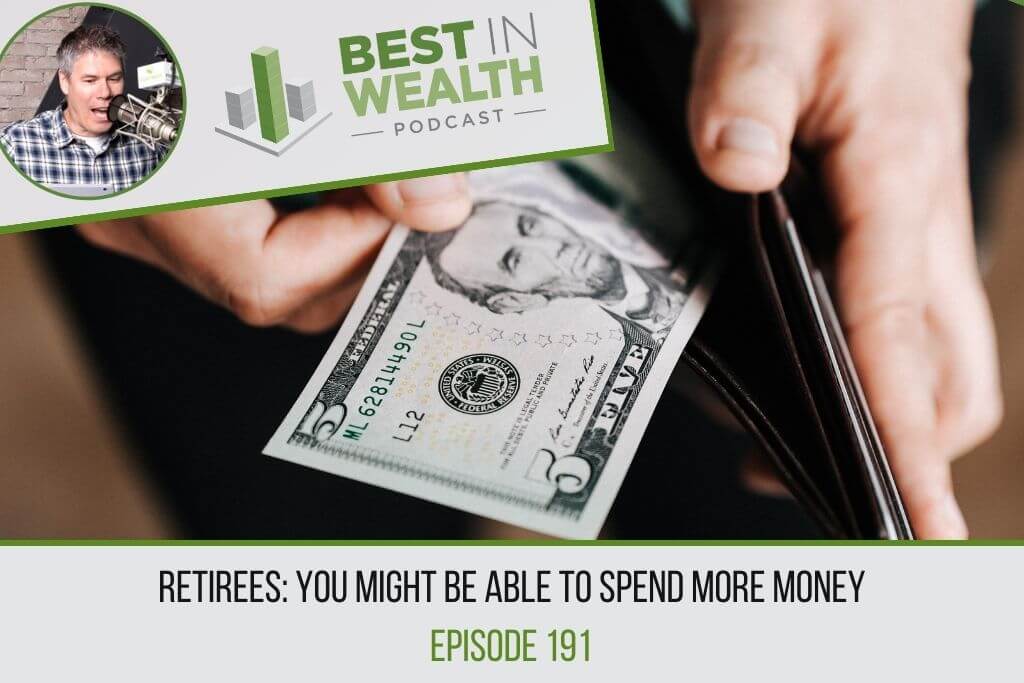Retirees: You Might Be Able to Spend MORE Money, Ep #191

I read an article in Barron’s entitled, “Retirees Aren’t Spending Enough of Their Nest Eggs. Here’s Why.” Why are people not spending enough? Should retirees be spending more? How do you figure out how much you can spend? In this episode of Best in Wealth, I talk about sequence of return risk, the Bengen Rule, and how you can live your best life in retirement—by spending more.
Retirees: You might be able to spend MORE in retirement. Learn how in this episode of the Best in Wealth Podcast! #wealth #retirement #investing #PersonalFinance #FinancialPlanning #RetirementPlanning #WealthManagement Click To TweetOutline of This Episode
- [1:26] Making financial decisions in the context of your life
- [5:32] You probably will not spend enough in retirement
- [8:34] Understanding the sequence of return risk
- [12:48] What happens when you follow the Bengen Rule
- [16:48] How to live your best life in retirement
- [23:23] Why everything comes down to planning
You probably will not spend enough in retirement
That statement seems odd, right? Don’t most people overspend? The truth is that you can probably spend more in retirement than you are going to. A couple came to Fortress Planning Group a few weeks ago. Their financial advisor had developed a financial plan and told them they had a 90% probability of being able to retire in three years.
They walked through the plan. The advisor shared what things would look like at the end of their plan—if the wife lived until 94 and the husband lived until 92. He estimated they would have millions of dollars left. He told them that’s what made the plan 90% probable.
The couple looked at each other and said, “I think we want to retire much earlier—why not today?” Their advisor quickly told them their probability of success would decrease significantly. They came to me for a second opinion.
Understanding the sequence of return risk
It is usually my goal to help clients avoid overspending. Most people nearing retirement are concerned they will not make it through retirement. That is why advisors need to explain the potential downsides of sequence of return risk to permanently reduce a client’s safe spending rates for the remainder of their retirement. What does that mean?
If my couple has millions of dollars left, why are they not taking out more now? Why don’t they take out 7%? If their average return is around 9%, why can they not take out 9%? Because of sequence of return risk. Let’s say you have $1 million. You want to leave your kids money when you die but they do not need millions. So you are going to take out 7% per year. Let’s say year one is a bad year and your portfolio decreases 25%. That’s $250,000 you’re losing on paper. At the end of year one, you’re left with $680,000.
Year two was also poor. Your portfolio is down another 15%, and at the end of year two, you are left with $480,000—less than HALF of what you started with. The stock market goes on a bull run for several years but you are still withdrawing $70,000 every year. Because it is only at $480,000, you are suddenly taking out 14.5% of your portfolio to get $70,000 to live on. Because of sequence of return risk, you never get back to where you need to be. Your portfolio ends up running out of money. This is a real risk that cannot be discounted. But people are dying with millions in their portfolios. So can they spend more? Yes, probably…
How does the sequence of return risk impact what you can withdraw from your retirement accounts annually? Learn all about it in this episode of Best in Wealth! #wealth #retirement #investing #PersonalFinance #FinancialPlanning #RetirementPlanning… Click To TweetWhat happens when you follow the Bengen Rule
These are the people that love watching the number in their retirement accounts increase. No amount of new cars, new vacations, and new homes will replace that feeling. I will leave these people alone, there is no reasoning with them. The other subset of people is already doing everything they want to do. But the majority of people do not spend more because they are afraid they are going to run out, they do not want to be a burden on their kids, or they are relying too much on their portfolio for income. Too many people are sticking to a 3–4% withdrawal rate because they are sticking to the Bengen Rule.
The Bengen Rule dictates that you withdraw 4% every year and only take a raise for inflation. If you are going to be around for 30 more years, there is a 93% chance that you will never have to change a thing—with the right portfolio. But what about halfway through the trial? The research shows that the median return is ending up with what you started with—$1 million. Only 7% of 1,000 trials ran out of money. But over half ended with more than they started with. Some ended with $2 million or more by following the Bengen rule. So again—could they be spending more? The answer is likely yes.
How to live your best life in retirement
I want you to live your best life in retirement. So what is the fix? Be flexible.
- Lower your monthly expenses: Pay off your house before you retire. You will spend more in retirement when you have a lower monthly output. You will be less reliant on your portfolio to survive.
- Eliminate ALL debt whenever possible: Pay cash for your vehicles when you can.
- Do your best to have monthly spending taken care of in inflation-protected annuity-type payments: David Blanchett and Michael Finke found that spending in retirement is greater for individuals who receive a larger portion of their income from guaranteed sources such as defined benefit pensions, annuities, social security, etc. If you can get annuity-type payments for regular expenses, research suggests that you will end up spending more in retirement because you are not reliant on your nest egg.
- Delay collecting social security: If you delay it as long as possible, you and your spouse get an 8% raise every year you delay. You might have enough in social security to cover monthly expenses.
- Come up with an inflation-protected bond or security that’s laddered: Work with an advisor to do this.
All of these things afford you flexibility. Your life, the returns you see in the stock market, inflation—it will all fluctuate. That is why flexibility is key. It is also why Fortress Planning Group follows the Guyton Rules for retirement planning. We help you determine if you can spend more systematically and thoughtfully. Learn more about it in this episode of Best in Wealth.
Learn how you can live your best life in retirement in this episode of the Best in Wealth podcast! #wealth #retirement #investing #PersonalFinance #FinancialPlanning #RetirementPlanning #WealthManagement Click To TweetResources Mentioned
- Retirees Aren’t Spending Enough of Their Nest Eggs. Here’s Why.
- 4 Factors that Help Determine What You Need to Save for Retirement
- Guaranteed Income: A License to Spend
Connect With Scott Wellens
- Schedule a discovery call with Scott
- Send a message to Scott
- Visit Fortress Planning Group
- Connect with Scott on LinkedIn
- Follow Scott on Twitter
- Fortress Planning Group on Facebook
Audio Production and Show notes by
PODCAST FAST TRACK
https://www.podcastfasttrack.com
Podcast Disclaimer:
The Best In Wealth Podcast is hosted by Scott Wellens. Scott Wellens is the principal at Fortress Planning Group. Fortress Planning Group is a registered investment advisory firm regulated by the Securities Act of Wisconsin in accordance and compliance with securities laws and regulations. Fortress Planning Group does not render or offer to render personalized investment or tax advice through the Best In Wealth Podcast. The information provided is for informational purposes only and does not constitute financial, tax, investment or legal advice.



